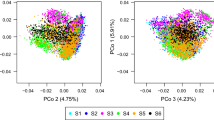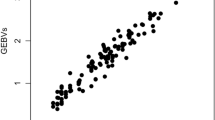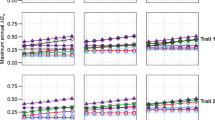Abstract
With best linear unbiased prediction (BLUP), information from genetically related candidates is combined to obtain more precise estimates of genotypic values of test candidates and thereby increase progress from selection. We developed and applied theory and Monte Carlo simulations implementing BLUP in 2 two-stage maize breeding schemes and various selection strategies. Our objectives were to (1) derive analytical solutions of the mixed model equations under two breeding schemes, (2) determine the optimum allocation of test resources with BLUP under different assumptions regarding the variance component ratios for grain yield in maize, (3) compare the progress from selection using BLUP and conventional phenotypic selection based on mean performance solely of the candidates, and (4) analyze the potential of BLUP for further improving the progress from selection. The breeding schemes involved selection for testcross performance either of DH lines at both stages (DHTC) or of S1 families at the first stage and DH lines at the second stage (S1TC-DHTC). Our analytical solutions allowed much faster calculations of the optimum allocations and superseded matrix inversions to solve the mixed model equations. Compared to conventional phenotypic selection, the progress from selection was slightly higher with BLUP for both optimization criteria, namely the selection gain and the probability to select the best genotypes. The optimum allocation of test resources in S1TC-DHTC involved ≥10 test locations at both stages, a low number of crosses (≤6) each with 100–300 S1 families at the first stage, and 500–1,000 DH lines at the second stage. In breeding scheme DHTC, the optimum number of test candidates at the first stage was 5–10 times larger, whereas the number of test locations at the first stage and the number of test candidates at the second stage were strongly reduced compared to S1TC-DHTC.
Similar content being viewed by others
References
Bauer AM, Reetz TC, Léon J (2006) Estimation of breeding values of inbred lines using best linear unbiased prediction (BLUP) and genetic similarities. Crop Sci 46:2685–2691
Bernardo R (1996) Best linear unbiased prediction of maize single-cross performance. Crop Sci 36:50–56
Bernardo R (2002) Breeding for quantitative traits in plants. Stemma Press, Woodbury, Minnesota
Bernardo R (2003) Parental selection, number of breeding populations, and size of each population in inbred development. Theor Appl Genet 107:1252–1256
Bernardo R (2009) Should maize doubled haploids be induced among F1 or F2 plants? Theor Appl Genet 119:255–262
Holland JB, Nyquist WE, Cervantes-Martinez CT (2003) Estimating and interpreting heritability for plant breeding: an update. Plant Breed Rev 22:9–112
Longin CFH, Utz HF, Reif JC, Wegenast T, Schipprack W, Melchinger AE (2007) Hybrid maize breeding with doubled haploids: III. Efficiency of early testing prior to doubled haploid production in two-stage selection for testcross performance. Theor Appl Genet 115:519–527
Lorenzana RE, Bernardo R (2009) Accuracy of genotypic value predictions for marker-based selection in biparental plant populations. Theor Appl Genet 120:151–161
Melchinger AE (1987) Expectation of means and variances of testcrosses produced from from F2 and backcross individuals and their selfed progenies. Heredity 59:105–115
Melchinger AE, Utz HF, Schön CC (1998) Quantitative trait locus (QTL) mapping using different testers and independent population samples in maize reveals low power of QTL detection and large bias in estimates of QTL effects. Genetics 149:383–403
Melchinger AE, Longin CFH, Utz HF, Reif JC (2005) Hybrid maize breeding with doubled haploid lines: quantitative genetic and selection theory for optimum allocation of resources. In: Proceedings of the forty-first annual Illinois Corn Breeders’ School 2005, Urbana-Champaign, Illinois, USA, pp 8–21
Piepho HP, Möhring J, Melchinger AE, Büchse A (2008) BLUP for phenotypic selection in plant breeding and variety testing. Euphytica 161:209–228
R Development Core Team (2006) R: A language and environment for statistical computing. R Foundation for Statistical Computing. Vienna, Austria. ISBN: 3-900051-07-0, URL http://www.R-project.org
Robinson GK (1991) That BLUP is a good thing: the estimation of random effects. Stat Sci 6:15–51
SAS Institute (2004) SAS Version 9.1. SAS Institute, Cary, NC
Schrag TA, Möhring J, Melchinger AE, Kusterer B, Dhillon BS, Piepho HP, Frisch M (2010) Prediction of hybrid performance in maize using molecular markers and joint analyses of hybrids and parental inbreds. Theor Appl Genet 120:451–461
Searle SR (1996) The matrix handling of BLUE and BLUP in the mixed linear model. Linear Algebra Appl 264:291–311
Smith JSC, Hussain T, Jones ES, Graham G, Podlich D, Wall S, Williams M (2008) Use of doubled haploids in maize breeding: implications for intellectual property protection and genetic diversity in hybrid crops. Mol Breed 22:51–59
Wegenast T, Longin CFH, Utz HF, Melchinger AE, Maurer HP, Reif JC (2008) Hybrid maize breeding with doubled haploids. IV. Number versus size of crosses and importance of parental selection in two-stage selection for testcross performance. Theor Appl Genet 117:251–260
Wegenast T, Utz HF, Longin CFH, Maurer HP, Dhillon BS, Melchinger AE (2010) Hybrid maize breeding with doubled haploids: V. Selection strategies for testcross performance with variable sizes of crosses and S1 families. Theor Appl Genet 120:699–708
Wolfram Research, Inc. (2008) Mathematica, Version 7.0. Champaign, IL
Acknowledgments
This research was supported by funds from DFG, Grant 1070, International Research Training Group “Sustainable Resource Use in North China” to T. Wegenast. Financial support for X. Mi was provided by Grant 0315072B “GABI Gain” within the framework “Genome analysis of the plant biological system” supported by the German Federal Ministry of Education, Research, and Technology. We greatly appreciate the helpful comments and suggestions of two anonymous reviewers.
Author information
Authors and Affiliations
Corresponding author
Additional information
Communicated by H. Becker.
X. Mi and T. Wegenast contributed equally to this work.
Rights and permissions
About this article
Cite this article
Mi, X., Wegenast, T., Utz, H.F. et al. Best linear unbiased prediction and optimum allocation of test resources in maize breeding with doubled haploids. Theor Appl Genet 123, 1–10 (2011). https://doi.org/10.1007/s00122-011-1561-4
Received:
Accepted:
Published:
Issue Date:
DOI: https://doi.org/10.1007/s00122-011-1561-4




